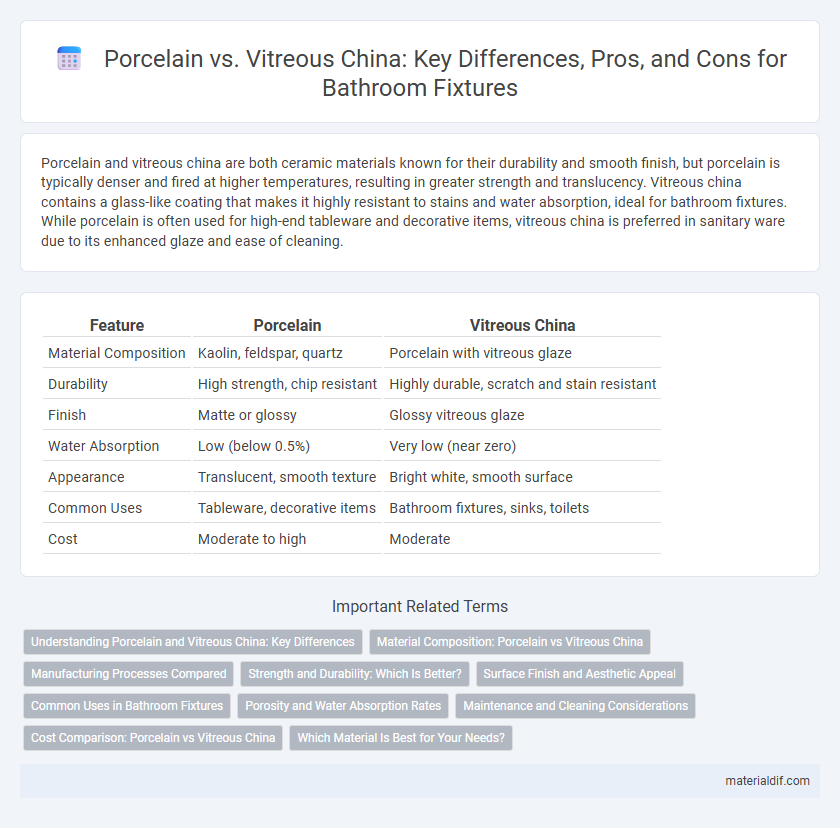Porcelain and vitreous china are both ceramic materials known for their durability and smooth finish, but porcelain is typically denser and fired at higher temperatures, resulting in greater strength and translucency. Vitreous china contains a glass-like coating that makes it highly resistant to stains and water absorption, ideal for bathroom fixtures. While porcelain is often used for high-end tableware and decorative items, vitreous china is preferred in sanitary ware due to its enhanced glaze and ease of cleaning.
Table of Comparison
| Feature | Porcelain | Vitreous China |
|---|---|---|
| Material Composition | Kaolin, feldspar, quartz | Porcelain with vitreous glaze |
| Durability | High strength, chip resistant | Highly durable, scratch and stain resistant |
| Finish | Matte or glossy | Glossy vitreous glaze |
| Water Absorption | Low (below 0.5%) | Very low (near zero) |
| Appearance | Translucent, smooth texture | Bright white, smooth surface |
| Common Uses | Tableware, decorative items | Bathroom fixtures, sinks, toilets |
| Cost | Moderate to high | Moderate |
Understanding Porcelain and Vitreous China: Key Differences
Porcelain and vitreous china are both types of ceramic materials commonly used in sanitary ware, but porcelain is fired at higher temperatures, resulting in a denser, more durable structure with lower porosity. Vitreous china contains a higher percentage of glass-like frit, making it more resistant to water absorption and staining while maintaining a smooth, glossy finish. Understanding these distinctions helps in selecting the right material for specific applications, balancing durability, aesthetics, and maintenance requirements.
Material Composition: Porcelain vs Vitreous China
Porcelain is composed mainly of kaolin, feldspar, and quartz, resulting in a dense, non-porous, and highly durable ceramic material. Vitreous China differs by having a higher glass content in its composition, which makes it more vitreous and less porous, enhancing its water resistance and strength. Both materials undergo high-temperature firing, but porcelain's finer grain and denser composition contribute to its translucency and refined finish.
Manufacturing Processes Compared
Porcelain undergoes high-temperature firing at approximately 1,300degC, resulting in a vitrified, dense, and highly durable material with a translucent quality. Vitreous china is fired at a slightly lower temperature, around 1,200degC, with a glassy coating applied to enhance its waterproof and stain-resistant properties. The manufacturing process of porcelain involves finer raw materials like kaolin clay, feldspar, and silica, whereas vitreous china uses a coarser mixture and glazing for its characteristic glossy finish.
Strength and Durability: Which Is Better?
Porcelain exhibits higher density and lower porosity compared to vitreous china, resulting in superior strength and enhanced resistance to chipping or cracking. Vitreous china, while also durable, contains a glass-like coating that provides additional protection against stains but is generally less robust under impact stress. For applications demanding maximum durability, porcelain is the better choice due to its inherent hardness and long-lasting structural integrity.
Surface Finish and Aesthetic Appeal
Porcelain offers a smooth, glass-like surface finish that is highly non-porous, resisting stains and scratches while maintaining its glossy appearance over time. Vitreous china, infused with fused glass particles, delivers a similarly glossy surface but tends to have a slightly softer finish that can show wear more readily. Aesthetic appeal of porcelain leans towards a refined, translucent quality with a delicate elegance ideal for fine tableware, whereas vitreous china boasts a bright, durable shine suited for everyday use in sinks and bathroom fixtures.
Common Uses in Bathroom Fixtures
Porcelain is commonly used in bathroom fixtures such as sinks, toilets, and bathtubs due to its high density, durability, and resistance to water absorption, making it ideal for moist environments. Vitreous china, a type of porcelain with an added glassy coating, is frequently preferred for bathroom sinks and toilets because of its smooth, non-porous surface that resists stains and simplifies cleaning. Both materials provide strong, long-lasting finishes but vitreous china offers enhanced gloss and resistance to surface wear in daily bathroom use.
Porosity and Water Absorption Rates
Porcelain exhibits lower porosity and water absorption rates compared to vitreous china, making it more durable and less susceptible to moisture damage. Porcelain's density typically results in water absorption rates below 0.5%, while vitreous china ranges between 1% and 3%. This difference in porosity enhances porcelain's resistance to staining and improves its long-term performance in humid environments.
Maintenance and Cleaning Considerations
Porcelain requires gentle cleaning with non-abrasive, pH-neutral cleaners to maintain its smooth, glossy surface and prevent chipping or cracking. Vitreous china, being denser and more resistant to stains, tolerates a wider range of cleaning agents, including mild detergents and disinfectants, making maintenance easier in high-traffic areas. Both materials benefit from regular wiping to avoid buildup of soap scum and mineral deposits, but porcelain demands more careful handling to preserve its delicate finish.
Cost Comparison: Porcelain vs Vitreous China
Porcelain generally costs more than vitreous china due to its higher density, finer materials, and more complex manufacturing process. Vitreous china offers a more affordable option while maintaining durability and a smooth, glossy finish ideal for bathroom fixtures. The price difference can vary based on brand, design complexity, and geographic location, with porcelain often preferred for premium applications where cost is less of a concern.
Which Material Is Best for Your Needs?
Porcelain offers a denser, more durable composition with a smooth, glass-like finish ideal for fine tableware and decorative items, while vitreous china features a vitrified glaze that makes it highly resistant to chipping and moisture, perfect for bathroom fixtures like sinks and toilets. Porcelain's higher firing temperature results in increased strength and translucency, whereas vitreous china's non-porous surface ensures superior hygiene and long-lasting stain resistance. Choosing between porcelain and vitreous china depends on whether durability and aesthetic appeal for table settings or robust, low-maintenance performance in plumbing fixtures best suit your requirements.
Porcelain vs Vitreous China Infographic

 materialdif.com
materialdif.com